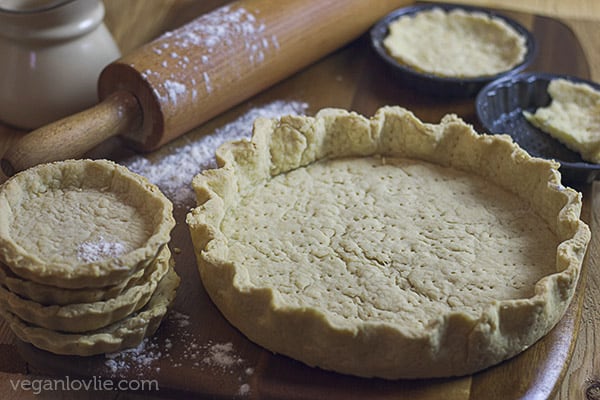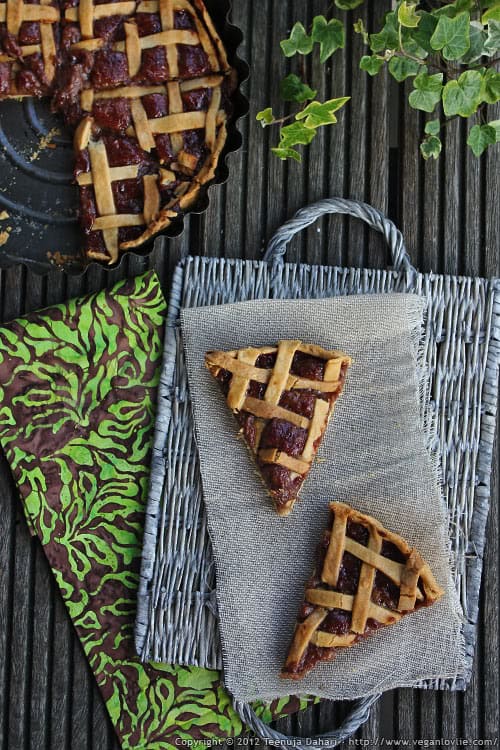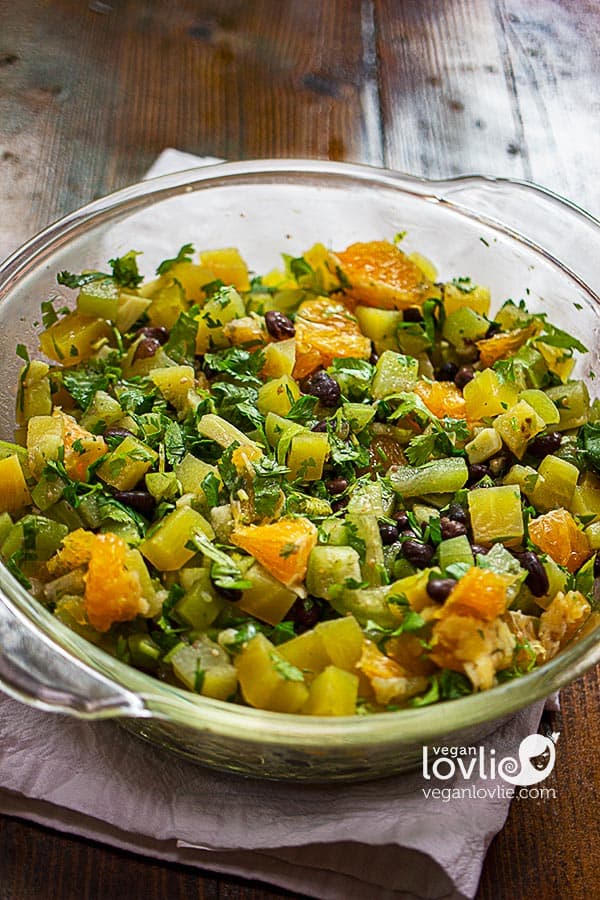Unless you are making a crustless pie, for me, no matter the filling, a great pie is one that has a good base – a flaky, buttery crust. What’s different in this shortcrust pastry is that it uses oil instead of butter or margarine.

While there are a few brands of vegan butter or margarine available on the market, the thing is, they are not available everywhere. So, this recipe makes it possible for those of you in that situation to still enjoy a good flaky delicious pie crust without the need for butter or margarine.

It might also be just a little bit healthier although that is not the main reason I am using oil here, but this oil-based crust is certainly a lot easier to work with. It literally takes away the hassle of trying not to over-handle the dough so as not to melt the butter, as it is the case with traditional shortcrust pastry. If you live in cold regions, this is not much of an issue. But in hot weather, it’s almost impossible to get the butter to stay solid after just 5 minutes outside of the fridge.
This oil-based crust, ironically enough, is also less oily and much lighter. Baking powder is not an ingredient that you would normally use in shortcrust pastry but I have used it in this recipe to keep the texture a little bit lighter as the oil alone with tend to make it dense.

In this recipe, I am using aquafaba. That’s the fancy name for bean juice or chickpea brine or water which I have talked about before. It’s the liquid that you collect from a can of beans, like chickpeas, white beans or butter beans. I’ve made my own aquafaba as I boil the beans from dry. So, after they are cooked, save the water in which they have been boiling. You can reduce this water to make it thicker. For this recipe though, we don’t need it to be too thick. So, the amount you’ll need will depend on the flour and the oil that you are using. I have used 6 tablespoons but you may need a little bit more or less.
For shortcrust pastry, I would recommend that you use weight measurement rather than volume as it is more precise and will ensure optimum results.
Oil-based Vegan Shortcrust Pastry Recipe | Vegan Pie Crust
Ingredients (one pie dish, 24-cm or 9-inch diameter)
2 1/4 cups [320 g, 11 oz] all-purpose (or pastry/cake) flour
3/4 teaspoon baking powder
1/4 teaspoon salt
6 tablespoons [90 ml, 80 g, 2.8 oz] sunflower oil (olive oil, grapeseed oil, vegetable oil or coconut oil are also good)
6 tablespoons [90 ml] aquafaba (or substitute with 1 teaspoon lemon juice + 5 tablespoons [75 ml] non-dairy milk)
Instructions
Into a large mixing bowl, add the flour, baking powder and salt.
Give the dry ingredients a mix and then add in the oil. Start working with your fingers and mix the oil around. Then, similar to making shortcrust pastry, gently rub in the flour and oil mixture with your fingers to create something that eventually looks like fine breadcrumbs.
Add the aquafaba. You may need to add 1 tablespoon more depending on the flour type. What we want to achieve is a rather soft non-sticky dough. So, press the moistened flour mixture to form a dough. You can do this on the board if it is easier instead of in the bowl. But do not knead this mixture. Work as little as possible with it to form the dough. Once a smooth ball is formed, you can proceed to rolling it out or you can keep it in the refrigerator for about 15 minutes before using it. This will firm it up a little bit and also produces a slightly better texture when baked.
The amount of dough in this recipe is enough for a 24-cm or 9-inch pie pan, or slightly larger. Roll out the dough to the size of the pan plus the depth. To transfer the dough into the pan, loosely wrap it around the rolling pin and then unwrap it onto the pan.
If the dough breaks, just fix it by pressing the pieces together. Shape and press the dough into the pan so that it fits snugly and then you can trim off any excess dough. You can re-roll these little bits for smaller pans or to cut out shapes to decorate the pie.
If you want to flute the edge, you can do this by lifting the dough from the edge and insert your index finger underneath it. Then pressing in on either side with the first two fingers of the other hand. Work in this way, all around. (The video above demonstrates this better).

To help the dough bake well and not puff up, prick it with a fork. You can also put some parchment paper on top of the crust with some weight onto it like dried beans, rice or baking beads to prevent it from puffing but I did not do this with this one as it does not seem to puff too much.

The crust itself will require 25 to 30 minutes to bake at 180 degrees Celsius or 350 degrees Fahrenheit. But for some recipes, you may need to only partially bake it before adding the filling, then bake again. So, go with the recipe.
Note: You can make this dough in advance and either freeze it or keep it for a day in the refrigerator. Then, just take it out and allow it to soften enough to be rolled out.
Some recipes you may want to try with this vegan pie crust:
Suggested Baking Equipment
Stainless steel mixing bowls
Rolling pin
Kitchen scale
Measuring jugs
Measuring cups and spoons
Set of Baking pans
Oil-based Vegan Shortcrust Pastry Recipe (No Butter/Margarine) | Vegan Pie Crust
Ingredients
- 320 g all-purpose flour , (or pastry/cake flour), [2 1/4 cups]
- 3/4 teaspoon baking powder
- 1/4 teaspoon salt
- 90 ml sunflower oil, (olive oil, grapeseed oil, vegetable oil or coconut oil are also good), [6 tablespoons, 80 g, 2.8 oz]
- 90 ml aquafaba, [6 tablespoons], or substitute with 1 teaspoon lemon juice + 5 tablespoons [75 ml] non-dairy milk
Instructions
- Into a large mixing bowl, add the flour, baking powder and salt. Give the dry ingredients a mix and then add in the oil.
- Start working with your fingers and mix the oil around. Then, similar to making shortcrust pastry, gently rub in the flour and oil mixture with your fingers to create something that eventually looks like fine breadcrumbs.
- Add the aquafaba. You may need to add 1 tablespoon more depending on the flour type. What we want to achieve is a rather soft non-sticky dough. So, press the moistened flour mixture to form a dough. You can do this on the board if it is easier instead of in the bowl. But do not knead this mixture. Work as little as possible with it to form the dough.
- Once a smooth ball is formed, you can proceed to rolling it out or you can keep it in the refrigerator for about 15 minutes before using it. This will firm it up a little bit and also produces a slightly better texture when baked.
- The amount of dough in this recipe is enough for a 24-cm or 9-inch pie pan, or slightly larger. Roll out the dough to the size of the pan plus the depth. To transfer the dough into the pan, loosely wrap it around the rolling pin and then unwrap it onto the pan.
- If the dough breaks, just fix it by pressing the pieces together. Shape and press the dough into the pan so that it fits snugly and then you can trim off any excess dough. You can re-roll these little bits for smaller pans or to cut out shapes to decorate the pie.
- If you want to flute the edge, you can do this by lifting the dough from the edge and insert your index finger underneath it. Then pressing in on either side with the first two fingers of the other hand. Work in this way, all around. (The video above demonstrates this better).
- To help the dough bake well and not puff up, prick it with a fork. You can also put some parchment paper on top of the crust with some weight onto it like dried beans, rice or baking beads to prevent it from puffing but I did not do this with this one as it does not seem to puff too much.
- The crust itself will require 25 to 30 minutes to bake at 180 degrees Celsius or 350 degrees Fahrenheit. But for some recipes, you may need to only partially bake it before adding the filling, then bake again. So, go with the recipe.
Video
Notes

I have some upcoming delicious pie recipes using this crust, like this popular Mauritian custard pie to which I’ve added a little twist. So, check back soon.
Here’s another Mauritian Banana Pie recipe that you can make with this crust.





will it works with gluten free fluor?
Do u think I could substitute af + oil in let’s say cinnamon buns? How much af + oil equals 100g butter?
What difference do you think using aquafaba makes? I’ve been thinking about using it in my pastry, keen to know if you think it works well, and what the benefit of using it is.
It keeps the pastry lighter and flaky. Oil-based crusts tend to be denser than shortcrust pastry made with margarine (or vegan butter). So, in this recipe, it works really well and makes it less dense. I would think it would work well even with margarine/butter.
Looks amazing! How do you know when the AF is thick enough? I’ve never reduced AF before.
Just get it to be the same consistency as the AF in a can. It should be just slightly viscous. 🙂
Looks yummy! How would I make aquafaba?
Aquafaba is the liquid that beans have been boiling in. After the beans have boiled, save the remaining liquid. You can thicken it if it is too thin.
You can also just collect the liquid from a can of beans like chickpeas, white beans etc. Light coloured beans are preferred for aquafaba as darker beans will yield a darker coloured aquafaba which may not be suitable for some recipes. I hope this helps.
Hello beautiful! I needed pate brisée for a recipe I was making, so I just went out and bought a Vegan one, but I’m adding a link to this great recipe of yours so my readers can make it if they want to. Next time I’m making it from scratch using your recipe for sure 🙂
Amazing! I’m looking forward to trying this recipe- have been wanting to ‘level up’ to making vegan pastry for a while now.
This is a fantastic recipe, thank you and well done nailing a nice and flaky vegan pastry 🙂
Thank you Winter. <3 🙂
Hello vegan lovlie, if you were going to make a sweet shortcrust pastry what would you suggest ?
I can’t say for sure as I haven’t tried this method of making shortcrust pastry in a sweet version. I would probably try with adding sugar (in powdered form perhaps) to the flour. I will have to test it out to be able to provide an accurate recipe.
Hi. I’ve been looking everywhere for an easy to make butter free pastry, as I can’t seem to find a palm oil free Vegan butter.
Can I ask would this be ok for a mushroom wellington? It’ll will be my first attempt at a full Vegan Christmas! Looking forward to attempting it.
Hi T, yes this crust is suitable for a mushroom wellington. I used it to make savoury pies every now and then, or this Tofu en Croute (https://veganlovlie.com/daring-cooks-challenge-december-2009/) on the blog, that is very similar to a wellington and it works brilliant. I hope this helps. Happy Vegan Christmas! 🙂
I use whole wheat pastry flour as my “all purpose” flour. Figure I’ll try it with this to see how it goes, but thought I’d ask you what your thoughts are. Plus plan on using avocado oil.
I love your take on things…thank you for your efforts & sharing!
I also use whole wheat flour when I can. Will whole wheat flour work with this recipe?
I’m guessing it will. You will need to adjust the oil and aquafaba/plant-based milk though, to slightly more, as whole wheat flour will absorb more liquid. But don’t add too much or the crust will become hard instead of flaky.
Fantastic, simple recipe that was perfect for making baked pasties. The crust was golden and delicious – a real hit for my daughter’s packed lunch. I just blitzed it all in a blender and used a mix of olive and canola oils (2:4) for a bit of olive oil flavour. Thank you so very much for sharing this!
That’s wonderful Shelley! Thank you for the feedback. 🙂
I just made this for the first time for vegan guests and they loved it and so did I! This is also my first time leaving a review on a recipe, I must say I am very impressed! Thank you.
Thank you for this lovely review. Glad you enjoyed the pastry. 🙂
Thank you for posting this recipe, as we are eating WFPB and do not use margarine of any kind.
Quick question:
I use Einkorn or Emmer wheat flour (which tends to be more elastic or gooey than modern commercial wheat flour. Has anyone been able to make this crust with Einkorn or Emmer flour? Are there any adjustments needed?
Can’t wait to try this! Have you tried it as a crust for a galette? Recently had a great vegetarian galette but crust was loaded with butter.
It should work for a galette too, yes. 🙂